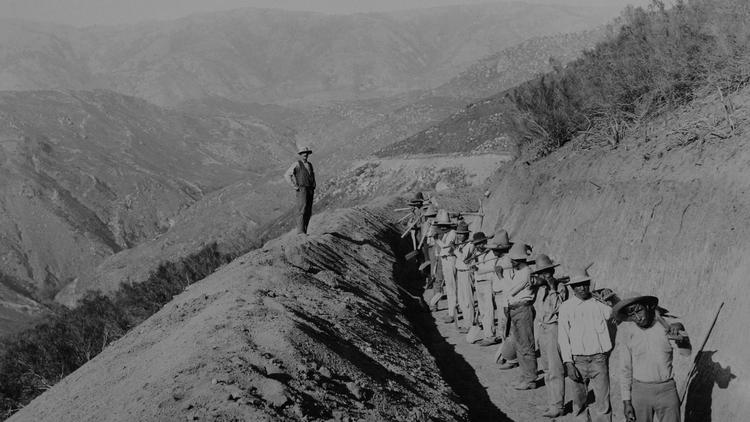The San Diego Union - Tribune
October 12, 2017
By J. Harry Jones

This photo of the "finishing" workers laboring on the Escondido Canal shows Palomar Mountain in the distance; it was taken by Percy Cox in the 1890s. (The Escondido Historical Society)
In 1967, Robert Pelcyger was a newly minted lawyer who knew little about the rights of Native Americans and even less about water rights.
Then he met Patty Durro, an earnest, young woman from the Rincon Band of Luiseno Indians in northern San Diego County who was determined to reclaim her tribe's share of the San Luis Rey River.
She changed his life and the fortunes of five North County tribes that had been robbed of the water they had been promised by the government.
But it took Pelcyger 50 years to right the wrong.

Attorney Robert Pelcyger worked on the San Luis Rey Indian water case for nearly five decades. (J. Harry Jones)
The journey began with a stack of government contracts from the 1900s.
Pelcyger had been hired to learn tribal law for a government nonprofit that was providing legal services to rural California residents and was hosting a workshop at the University of California, Riverside when he was approached by Durro.
“She was there to complain because their wells were going dry,” Pelcyger remembers. “Patty Durro came up to me during the meeting and gave me some (1914) contracts and said, ‘you’re a lawyer, tell me what these mean.’
“I looked at them and saw all kinds of words I’d never seen before and didn’t understand, so I told her I’d take a look at it. That was the beginning of the San Luis Rey litigation.”
Soon, Pelcyger and a colleague formed California Indian Legal Services, a law firm specializing in Native American issues.
“During the next couple of years, I tried to find other lawyers who would take the case but wasn’t able to do that," he said. "It got to the point I had to file something so I did it in 1969.”
The goal of the lawsuit, which went all the way to the U.S. Supreme Court in 1984 and was followed by decades of settlement talks, “was to correct this historical injustice the government had created shortly after the reservations were established,” Pelcyger said.
The reservations were purposely located in areas with access to water so the tribes could irrigate crops in an otherwise arid environment.
“No sooner had the reservations been created when, through a series of measures, the government gave away the same water they had given to the Indians to Escondido and Vista," Pelcyger said. "The bands were dedicated to correcting the historical injustice.”

Water diverted from the San Luis Rey River ends up in Lake Wohlford near Escondido. From there it is piped to a treatment plant and then distributed to Escondido water users or piped another 14 miles to the Vista Irrigation District. (J. Harry Jones)
Canals were built in the 1890s diverting the San Luis Rey River to farmers in those two cities, making it possible for those communities to thrive. In the 1920s, Lake Henshaw near Warner Springs was built and a diversion dam took even more of the river water to the cities via Lake Wohlford in the hills just east of Escondido.
The result was that during dry years the river barely flowed through the reservations, the underground aquifer fed by the river suffered and the Indians wells would dry up. Even today, the two cities rely on the San Luis Rey water for between 20 percent and 30 percent each year.
The lawsuit was filed on behalf of the aggrieved tribes against Escondido and the Vista Irrigation District.
“What is ironic is that our adversaries were Escondido and Vista, but it wasn’t their fault to begin with,” said Bo Mazzetti, chairman of the Rincon Band of Luiseno Indians.
“The federal government gave away the water twice. It gave it to the tribes and then authorized the dam and the diversion.”
Fifteen years after the lawsuit was filed, Pelcyger found himself arguing before the U.S. Supreme Court.
The ruling of the court, which essentially said all the parties needed to start over, pleased no one.
“It was frustrating because it meant we had to keep litigating but in retrospect it turned out, many years later, ultimately the best outcome for all the clients.”
Instead of resuming litigation, a decision was made to go to the U.S. Congress, which in 1988 passed the San Luis Rey Indian Water Rights Settlement Act, which recognized the need to provide the tribes with a supplemental water supply to make up for the approximately 16,000 acre-feet of water they lost each year from the river. One acre-foot equals 325,851 gallons.
But there were still two more hurdles to overcome.
The first, which would take 15 years to resolve, was figuring out where the extra water would come from. In the mid-2000s, the All-American Canal, an 80-mile-long aqueduct near the U.S.-Mexican border that takes Colorado River water to the Imperial Valley and beyond, was lined to stop seepage.
The lining project saved 100,000 acre-feet of water each year. The first 16,000 acre-feet of that savings was earmarked for the tribes per the settlement act.
But just after the water source was identified, the second hurdle emerged.
Lawyers for the federal government decided to revisit the settlement and took the position that the word “supplemental” meant “replace or substitute.”
“The government interjected a new issue for the first time,” Pelcyger said.
They argued that the 16,000 acre-feet from the canal should replace the water that is taken from the river. The tribes said, no, the 16,000 acre-feet of canal water should be in addition to the water that had been diverted and that they should retain rights to the San Luis Rey.
Fourteen more years of argument and settlement talks followed. The feds never agreed to the tribe’s position, but did say they would accept the fact should Congress enact a law saying the tribes were entitled to the extra water. That happened in 2014.
A couple years more went by due to bureaucracy, but finally the 1988 settlement terms became law.
In May of this year, 50 years after first hearing about the river, the case came to an end.
The settlement guarantees five North County Indian tribes — Rincon, La Jolla, Pauma, Pala and San Pasqual — equal access to more than 5 billion gallons annually of Colorado River water to compensate them for the lost San Luis Rey River water.
The end result is that the water brought in from the Colorado River can be used by the five tribes equally. But should they not need the extra water, they must sell the excess water to the two cities at market rates.
“For Escondido, it means that this supply of water we’d originally been given in the late 1800s is now secure,” said Chris McKinney, Escondido’s utilities director.
“For us, it’s an enormous deal to finally have this settled and to also have the supply secured.”
“It was a long path to go down to get to this point,” said Marty Miller, president of the Vista Irrigation District’s board of directors. “But we finally worked our way through it. And on the backside we came out friends. We came out partners.”
The tribes rely now and will continue to rely on groundwater, which is made possible by the recharging of the San Luis Rey aquifer accomplished via water seeping into the ground from the river.
That means most of the extra water from the Colorado River will be sold by the tribe to the cities which use far more than that amount annually. There will always be a demand.
“For the Indians, it’s a source of income,” Pelcyger said.
Mazzetti said it’s a shame that almost all of the elders of the tribes who were there at the beginning of the litigation, not to mention generations of Indians before them, have passed on and could not see the final resolution.
“The impossible became possible,” the Rincon chairman said. “Where do you find new sources of water today? You don’t. Sixteen thousand acre-feet of water will be coming into the county -- a whole new source of water. That benefits the whole region."
For Pelcyger, the end of the case feels wonderful.
“I feel blessed to have had clients that are so dedicated and loyal,” he said. “Where else do you find clients that stick with the same attorney for 50 years?”
He said long before casino money came to the reservations, the bands were committed to correcting an historical injustice and weren’t going to compromise.
For him, that began with the 1967 Patty Durro meeting and continued with other tribal members for decades.
“She was a fierce advocate of getting back what the bands viewed as being rightfully theirs,” he said. Durro has become very private in recent years and did not respond to requests for interviews.
“It took a lot of courage for them to even enter the fray against pretty long odds,” Pelcyger said. “Their sense of history is so strong as is their sense of continuity,” “They wanted to rectify the injustices their parents and grandparents had to bare and also were looking forward toward future generations. It was never about immediate gratification.”
http://www.sandiegouniontribune.com/communities/north-county/sd-no-water-settlement-20170926-story.html

